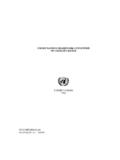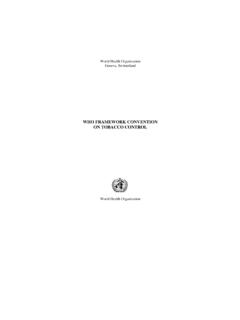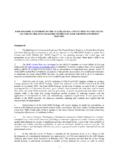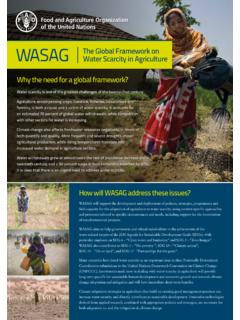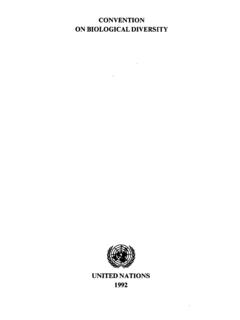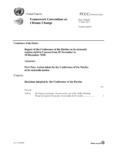Transcription of OFFICE OF THE UN SPECIAL ADVISER ON THE …
1 OSAPG Analysis Framework1 OFFICE OF THE UN SPECIAL ADVISER ON THEPREVENTION OF genocide (OSAPG)ANALYSIS FRAMEWORKL egal definition of genocideGenocide is defined in Article 2 of the Conventionon the prevention and Punishmentofthe Crime of genocide (1948)as"any of the following acts committed with intent to destroy, in whole or in part, anational,ethnical,racial orreligious group, as such: killing members of the group; causing serious bodily or mental harm tomembers of the group; deliberately inflicting on the group conditions of life calculated to bring about itsphysical destruction in whole or in part1; imposing measures intended to prevent births within the group; [and]forcibly transferring children of the group to another group."Elements of theframeworkTheAnalysisFramework comprises eight categories of factorsthatthe OSAPG usesto determine whether theremay bea risk of genocide in a given situation. The eight categories of factors are notranked, and theabsence ofinformation relating to one or more categories doesnot necessarily indicate the absence of a risk of genocide ;what issignificant isthe cumulative effect of the these factors are effectively addressed, nolonger exist or are no longer relevant, the risk of genocideis assumed to and , includingrecord ofdiscriminationand/or other humanrights violationscommitted against agroupIssues to be analyzed here include: Relations between and among groups in terms of tensions, power and economicrelations, including perceptions about the targeted group; Existing and past conflicts over land, power, security and expressions of groupidentity, such as language, religion and culture.
2 Past and presentpatterns of discrimination againstmembers of any group whichcould include:oSerious discriminatory practices, for instance, the compulsoryidentification of members of a particular group, imposition of taxes/fines,permission required for social activities such as marriage, compulsorybirth-control, the systematic exclusion of groups from positions of power,employment in State institutions and/or key professions2;oSignificant disparities in socio-economic indicatorsshowing a pattern ofdeliberate exclusion from economic resources and social and political life. Overt justification for such discriminatory practices; History of genocide orrelatedserious and massive human rights violationsagainst a particular group;denial by the perpetrators; References to past human rights violationscommittedagainst a possibleperpetrator group as a justification for genocidal acts against the targeted group inthe It might be necessary to determine if all or only a part of the group at risk within a specific geographical location is beingtargeted.
3 The aim of the genocide convention is to prevent the intentional destruction of entire human groups, and the parttargeted must be significant enough (substantial)to have an impact on the group as a substantiality requirementboth captures genocide s defining character as a crime of massive proportions (numbers) and reflects the convention sconcern with the impact the destruction of the targeted part will have on the overall survival of the group (emblematic).2 This could include security,law enforcement or oversight apparatus, such as police, army and Analysis affect thecapacity to preventgenocideStructures that exist to protectthepopulation and deter genocide include effectivelegislative protection; independentjudiciaryand effectivenational human rightsinstitutions, presence of international actors such as UN operations capable ofprotecting vulnerable groups, neutral security forces and independent to be analyzed here include: Existingstructures; The effectiveness of those structures; Whether vulnerable groups have genuine access to the protection afforded by thestructures; Patternsof impunity and lack of accountability for past crimes committed againstthe targeted groups.
4 Other options for obtaining protection against genocide , ofpeacekeepersin a position to defend the group, or seeking asylum in of illegalarms and armedelementsThe issues to be analyzed here include: Whether thereexistsa capacity to perpetrate genocide -especially, but notexclusively, by killing; How armed groups are formed, who arms them and what links they have to stateauthorities, if any; In cases of armed rebellions or uprising,whether a state has justifiedtargetinggroups from which armed actors have drawn their actors in theState/region; actswhich serve toencourage divisionsbetween national,racial, ethnic,andreligious groupsThe issues to be analyzed here include: Underlyingpolitical, economic, military or other motivation to target a group andto separate it from the rest of the population; The use of exclusionary ideology and the construction of identities in terms of us and them to accentuate differences; Depiction ofatargeted group as dangerous, disloyal, a security or economic threator as unworthy or inferior so as to justify action against the group; Propaganda campaigns and fabrications about the targeted group used to justifyacts against a targeted group by use of dominant, controlled media or mirrorpolitics 3; Any relevant role, whether active or passive, of actors outside the country ( ,other Governments, armed groups based in neighboring countries, refugee groupsordiasporas) and respective political or economic facilitateperpetration ofgenocide (dynamicfactors)Issues to be analyzed here include:Anydevelopment of events, whethergradual orsudden,thatsuggest a trajectorytowards the perpetration of genocidal violence, or the existence of a longerterm planor policy to commit genocide .
5 Examples: Sudden or gradual strengthening of the military or security apparatus; creation ofor increased support to militia groups ( , sudden increases in arms flow) in theabsence of discernible legitimate threats; Attempts toreduce oreradicate diversity within the security apparatus; Preparation of localpopulation to use them to perpetrate acts; Introduction of legislation derogating the rights of a targeted group; Imposition of emergency or extraordinary security laws and facilities that erodecivil rights and liberties;3 Mirror politics is a common strategy to create divisions by fabricating events whereby a person accuses others of whathe or she does or wants to Analysis Framework3 Sudden increase in inflammatory rhetoric or hate propaganda, especially byleaders, that sets a tone of impunity, even if it does not amount to incitement togenocidal violence in itself; Permissive environment created by ongoing armed conflict that could facilitateaccess to weapons and commission of actsIssues to beanalyzed here include: Acts that could be obvious elements of the crime of genocideas defined inArticle 6 ofthe Rome Statute,4 such as killings, abduction and disappearances,torture, rape and sexual violence; ethnic cleansing or pogroms;5 Lessobvious methods of destruction, such asthe deliberate deprivation ofresources needed for the group s physical survival and which are available to therest of the population, such as clean water, food and medical services;6 Creation of circumstances thatcould lead to a slow death, such as lack of properhousing, clothing and hygiene or excessive work or physical exertion.
6 Programsintended to prevent procreation, including involuntary sterilization,forced abortion, prohibition of marriage and long-term separation of men andwomen; Forcible transfer of children, imposed by direct force or through fear of violence,duress, detention, psychological oppression or other methods of coercion; Deaththreatsorill treatment thatcauses disfigurement or injury;forced or coerceduse of drugs or other treatmentthat damages of intent to destroy in wholeor in part .. 7 Issues to be analyzed here include: Statements amounting to hate speech8 bythose involved ina genocidal campaign; In a large-scale armed conflict, widespread and systematic nature of acts; intensityand scale of acts and invariability of killing methods used against the sameprotected group; types of weapons employed (in particular weapons prohibitedunder international law) and the extent of bodily injury caused; In anon-conflictsituation, widespread and/or systematic discriminatory andtargeted practices culminating in gross violations of human rights of protectedgroups, such as extrajudicial killings, torture and displacement; Thespecific means used to achieve ethnic cleansing which may underscore thatthe perpetration of the acts is designed to reach the foundations of the group orwhat is considered as such by the perpetrator group.
7 The nature of the atrocities, ,dismemberment of those already killed thatreveal a level of dehumanizationof the groupor euphoriaat having total controlover another human being, or the systematic rape of women which may beintended to transmit a new ethnic identity to the child or to cause humiliation andterror in order tofragment the group; The destruction of or attacks on cultural and religious property and symbols of thetargeted group that may be designed to annihilate the historic presence of thegroup or groups; Targeted elimination of community leaders and/or men and/or women of aparticular agegroup(the future generation or a military-age group); Other practices designed to complete the exclusion of targeted group fromsocial/political Rome Statute of the International Criminal should be made to gather information on a sufficientnumber ofincidents to determinewhether the abuses weresubstantial, systematic and widespread over a period of of the means to sustain life can be imposed through confiscation of harvests, blockade of foodstuffs, detentionin camps, forcible relocation or expulsion to inhospitable Analysis factorsIssuesto be analyzed here include:Future events or circumstances seemingly unrelated to genocidethatmightaggravateconditions or sparkdeterioration in the situation, pointing to the likely onset of agenocidal triggers might include: Upcoming elections (and associated activities such as voter registration orcampaigning; revision of delimitation of electoral boundaries; a call for earlyelections or the postponement or cancellation of elections.)
8 Disbanding of electioncommissions; imposition of new quotas/standards for political party or candidateeligibility); Change of Government outside of an electoral or constitutionally sanctionedprocess; Instances where the military is deployed internally to act against civilians; Commencement of armed hostilities; Natural disasters that may stress state capacity and strengthen active oppositiongroups; Increases in opposition capacity, which may be perceived as a threat andpromptpreemptive action, or rapidly declining opposition capacity which may invite rapidaction to eliminate problem intent can develop gradually, , in the course of conflict and not necessarily before, and genocide may beused as a tool or strategy to achieve military goals in an operation whose primary objective may be unrelated to thetargeted of intent to destroy can be inferred from a set of existing facts which would suggest that what isunfolding or ongoing may be genocide .
9 From a preventive perspective, there could be other indications of a plan or policyor an attempt to destroy a protectedgroup before the occurrence of full-blown The hate speech has to denigrate characteristics of a specific ethnic/racial/religious/national moments can also represent moments of opportunity to improve a situation and to lessen the risk of genocide .











